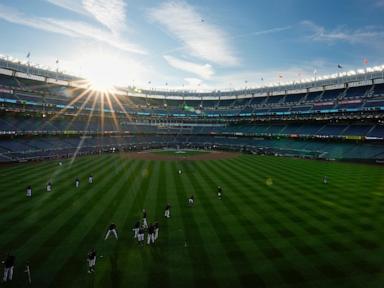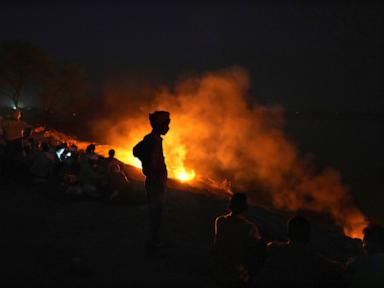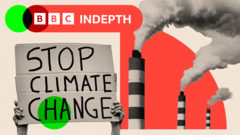Climate change is drying out the US West, even when rain pours: Study

Climate change-induced warming is drying out the American West by not only reducing precipitation, but also by accelerating evaporation — even amid adequate rainfall, a new study has found.
Evaporation accounted for 61 percent of the region's drought severity from 2020 to 2022, while reduced precipitation was responsible for just 39 percent of these conditions, according to the study, published Wednesday in Science Advances.
Historically, drought in the U.S. West was driven by a lack of rainfall, while evaporative demand — the amount of water that the atmosphere can absorb from the Earth's surface — has only played a small role, the study authors noted.
But climate change caused by burning fossil fuels has brought about higher average atmospheric temperatures and has increased the contributions of evaporation to drought severity, the researchers explained.
“For generations, drought has been associated with drier-than-normal weather,” co-author Veva Deheza, executive director of the National Oceanic and Atmospheric Administration's National Integrated Drought Information System, said in a statement.
“This study further confirms we’ve entered a new paradigm where rising temperatures are leading to intense droughts, with precipitation as a secondary factor," Deheza added.
To explore the impacts of higher temperatures on drought, the researchers separated "natural," weather-driven droughts from those they attributed to climate change across a 70-year period.
They found that climate change was responsible for 80 percent of the surge in evaporative demand since 2000 and that during drought periods, this figure rose to more than 90 percent.
Climate change, they concluded, has been "the single biggest driver increasing drought severity and expansion of drought area since 2000."
Comparing the 2000-2022 period to the 1948-1999 period, the scientists saw a 17 percent rise in average drought area due to an increase in evaporative demand.
Since the turn of the century, about 66 percent of the historical and emerging drought-prone areas had high evaporative demand that could alone cause drought — regardless of precipitation status, according to the study.
Prior to the year 2000, the same could only be said for 26 percent of that region, the researchers noted.
“During the drought of 2020–2022, moisture demand really spiked,” corresponding author Rong Fu, a professor of atmospheric and oceanic sciences at the University of California Los Angeles, said in a statement.
A warmer atmosphere ends up holding more water vapor before the air mass becomes saturated and enables precipitation, the scientists explained. Heat keeps the water molecules moving and bouncing off each other, rather than condensing — a requirement for rainfall.
The result is a cycle in which the warmer the planet becomes, the more water will evaporate, but a smaller fraction will return as rain, according to the authors.
Fu explained that although the 2020-2022 drought period started with a natural decline in rainfall, its severity rose "from the equivalent of ‘moderate’ to ‘exceptional’ on the drought severity scale due to climate change.”
"Moderate" equates to about the 10 percent to 20 percent strongest droughts, while "exceptional" refers to the top 2 percent most severe droughts, per the U.S. Drought Monitor.
The scientists warned that severe droughts will likely go from exceedingly rare occurrences to happening every 60 years by the mid-21st century and every six years by the end of the century.
“Even if precipitation looks normal, we can still have drought because moisture demand has increased so much and there simply isn’t enough water to keep up with that increased demand,” Fu said.
“The only way to prevent this is to stop temperatures from increasing, which means we have to stop emitting greenhouse gases," Fu added.
Topics
-

Where has all the rain gone? Bone-dry October strikes much of US
Tech - ABC News - October 29 -

Climate change strengthened hurricanes by 18 miles per hour: Study
Politics - The Hill - 3 days ago -

‘Bomb cyclone’ brings high winds and soaking rain to north-west US
World - The Guardian - 4 days ago -
We don’t need the US to fight climate change
World - Financial Times - November 14 -

Asia needs to spend much more to adapt to climate change and limit its damage, bank study says
World - ABC News - October 30 -

Climate scores big wins in ballot measures across US West
Politics - The Hill - November 11 -

Will China step up if Trump takes a step back on climate change?
Top stories - BBC News - 2 days ago -

Rain, flooding and snow sock in parts of the West and Northeast
Top stories - NBC News - 12 hours ago -

Global carbon deal agreed even as US warns climate may be on ‘back burner’
Business - Financial Times - November 11
More from The Hill
-

Arrest warrants for Israeli leaders amplify Democratic rupture
Politics - The Hill - 1 hour ago -

Progressives begin search for a new leader
Politics - The Hill - 1 hour ago -

Eric Adams faces uncertain political future
Politics - The Hill - 1 hour ago -

What's next for Kamala Harris?
Politics - The Hill - 1 hour ago -

Hulk Hogan suggests Trump may nominate him for position in administration
Politics - The Hill - 8 hours ago